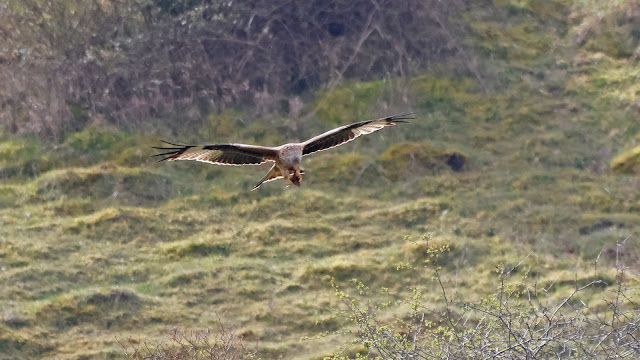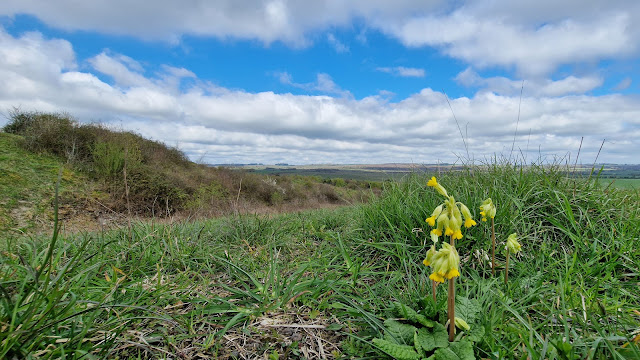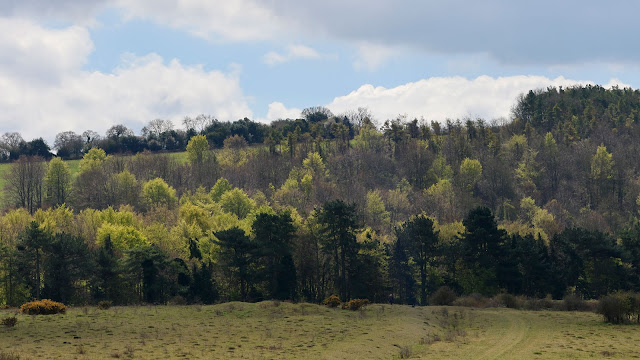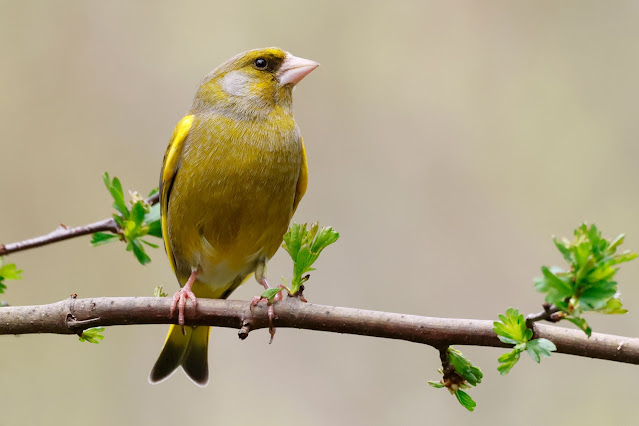Today I set off in a different direction to the north west border of Hampshire, it was very nice to drive through some different countryside as the sun came up in partially clear skies. I was meeting Ian at a location just outside the village of Over Wallop. We have been here at this time of year for the last two years in search of Stone Curlew. I arrived first and as I sorted myself out I noticed Ian's van stop at the bottom of the lane and him get out. I debated whether to go down to see what was going on, didn't move and regretted it when he eventually joined me. He had seen a Tawny Owl in the trees.
Whilst it was a dry sunny start it was cold with a fresh northerly wind blowing. We set off west down the bridleway, above us the Rooks were calling from there rookery and in the fields there several Stock Dove. Coming out into the open both Blackcap and Chiffchaff were singing in the surrounding bushes. A little further along we heard what seemed to be quite close the call of a Stone Curlew, but a search of the fields on both sides of the bridleway revealed nothing other than a couple of Brown Hare.
On reaching the "T" junction with the main bridleway that runs north to south, the scene behind us was quite superb, sunrise at his time of year is always spectacular
We could hear every so often the calls of the Stone Curlew coming from west of the path. The field in front of us was full of rapeseed that was just coming into flower and would hide almost everything if it was in the field. We opted to turn left and head south in the bushes we could hear the jangling song of Corn Bunting and above us in the morning sun was the first yellowhammer of the year.
Ian then picked up a Brown Hare running down the edge of the rape field.
While we waited to see if it would stop preening to come closer we could still hear the Stone Curlew calling. When it became clear that it was quite happy in the sunshine and shelter we decided to walk on.
This Corn Bunting was singing from the top of the bushes, and for once did not fly off.
In the first year we came the field to behind this view was left to fallow and the Stone Curlew showed well in there, last year they were around the patches in the field to the south, but this year with a lot of rape being grown it was difficult to see them. Hopefully the next year there will be some fallow fields once again.
We decided to head back to the cars and move on, we wanted to keep in the same area so opted for Martin Down, which was a thirty minute drive across the downs and through Salisbury. Parking in the lower car park there were Blackcap and Chiffchaff singing. This is one of my favourite places and it is always nice to visit at the start of spring. We walked along the main path south west towards the Bokerley Ditch. Along the ridge a Red Kite was using the uplift, then dropped to pick up something from the ground.
The ditch itself was almost empty of the thick dense vegetation that starts to go fom May onwards, there were very little flowering plants about so our hope of some butterflies was probably not going to happen. What flowers present were mostly Dandelion, but there were signs of cowslips emerging and some were well developed.
We followed the ditch to the intersection with the Jubilee Trail which heads south west alongside Blagdon Plantation. A Chiffchaff was very vocal by the start of the footpath and showed very well in amongst the Blackthorn blossom.
But the Chiffchaff is more complicated and is known to have
three commonly accepted subspecies, together with birds from the Iberian
Peninsula, the Canary Islands, and the Caucasus which are now
more often treated as full species.
The nominate species P. c. collybita breeds in Europe
east to Poland and Bulgaria,
P. c. abietinus occurs in Scandinavia and
northern Russia, and winters from southeastern Europe and northeastern
Africa east to Iraq and western Iran.
P. c. tristis, the Siberian chiffchaff, breeds in Siberia east
of the Pechora River and winters in the lower Himalayas.
The Canary Islands Chiffchaff is a non-migratory
species formerly occurring on the major Canary Islands, which is differentiated
from P. collybita by morphology, vocalisations and genetic
characteristics, and, of course, is not sympatric with any other
chiffchaffs.
The Mountain Chiffchaff, is found in the Caucasus (P. s. lorenzii) and Himalayas (P. s. sindianus), and is an altitudinal migrant, moving to lower levels in winter.
The female builds a domed nest on or near the ground and
assumes most of the responsibility for brooding and feeding the chicks, whilst
the male has little involvement in nesting, but defends his territory against
rivals, and attacks potential predators.
About half way along the path by the plantation there is a clump of conifers and as we passed there was a Goldcrest singing, but strangely we only saw amongst the branches and surrounding bramble a pair of Firecrests.
They showed well
Another scan with the thermal cameras of the field behind proved a success with a Brown hare hunkered down amongst the crops.
Walking on you come out into the open and have a view across yet another field of rape.
As we watched five Brown Hare came running out of the surrounding field and started to chase each other through the tramways of the rape field. W
We were being extremely lucky with the weather, the day was forecast to be overcast but we were having plenty of sunshine.
The trees around the footpath though were showing that beautiful fresh green appearance.
The trees on the north side provided good shelter from the wind and the south facing aspect made it quite a sun trap and as hoped for the butterflies appeared, first a female Brimstone that did not stop, but next a male that was much more confiding.
The Brimstone was then joined by an immaculate Peacock.
There are two species of Bee-fly to be seen commonly in the
UK these are the Dark-edged and Dotted Bee-fly.
There are two other species Heath and Western Bee-fly but these are
extremely localised. The dark-edged is
easily identified when seen at rest by the black border to the leading edge of
its wing. What we have here is the
scarcer Dotted Bee-fly which is identified by the black dots on the wings. These are difficult to see when in flight but
show well when resting.
The Whitethroat is a medium-sized, long-tailed warbler of
grassland, scrub and hedgerows. It is a summer visitor, arriving from
Sub-Saharan Africa in April breeding in many areas, but avoiding urban and
mountainous places.
Male Whitethroats build nests out of twigs and roots and the
females then decide which to take.
Whitethroats leave our shores in early October and head as
far as South Africa to overwinter.

















































































No comments:
Post a Comment